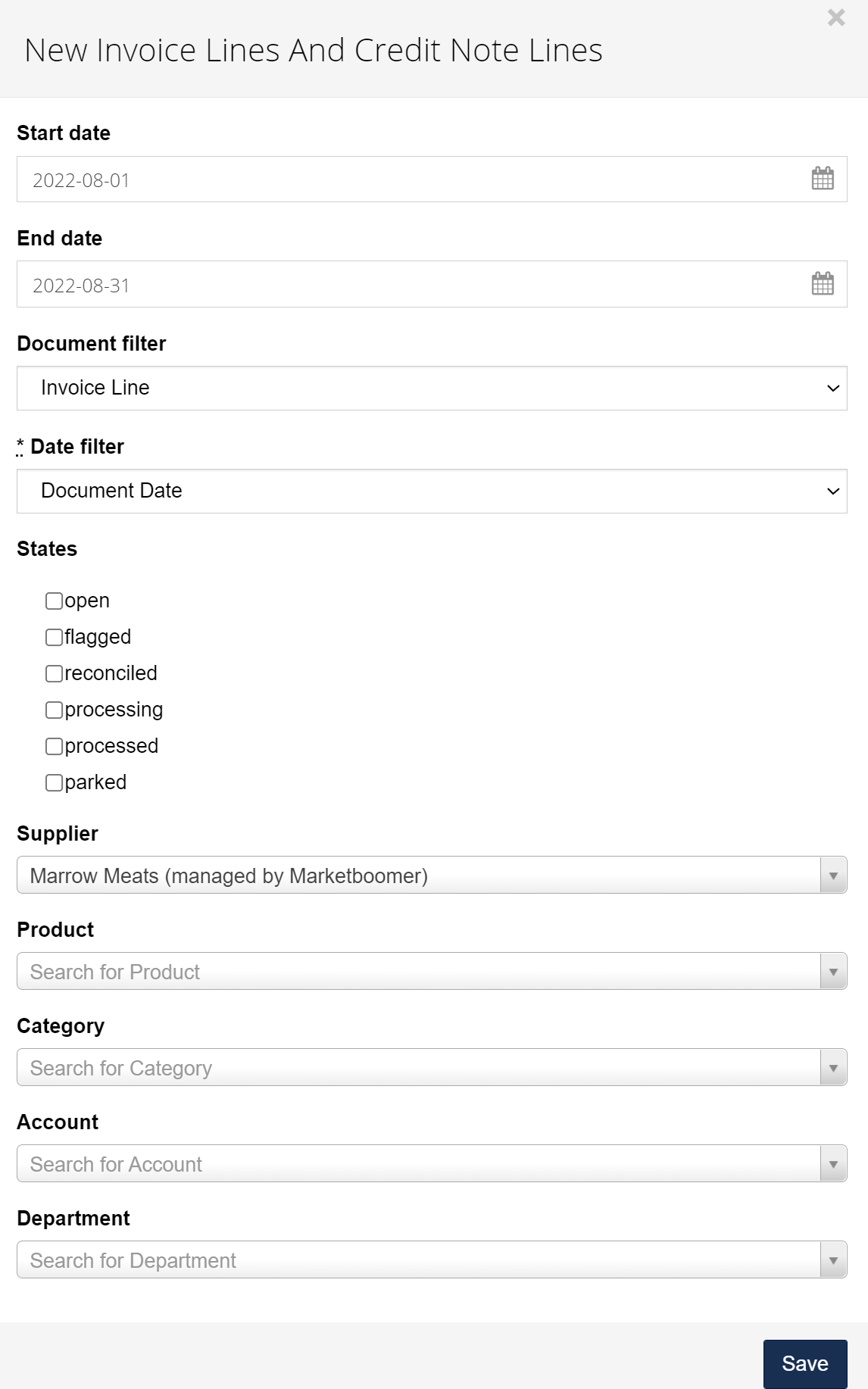Invoice lines can be used to then import into a Self Managed Pricing Catalog. This is especially useful for Informal Suppliers.
The following guide walks through how you can convert product lines from your invoices into items in a Self Managed Pricing Catalog for that Supplier. This is specifically useful for Informal Suppliers. Then you could optionally choose to import these items into a Buy List based on their Department/Account Code.
Note - This requires invoice line items to be read either by having a collection of ePDF invoices already in PurchasePlus or line item scanning turned on.
Exporting Invoice Lines
1. Go to [Snapshots] and click through to the [Invoices and Credit Note Lines] snapshot
2. Use the green [+] button to generate a new 'Invoices and Credit Note Lines' snapshot. Choose the month of items you wish to export and optionally choose to restrict this to the Supplier that you want to create a Self Managed Pricing Catalog for. 
You may wish to export all lines for the period if it is within the allowed number of lines to be exported.

3. Download the created Snapshot and open in Excel. If it does not let you generate the Snapshot, it likely exceeds the allowed number of lines to be exported and needs to be refined further.
Your export should have some key fields that can be used to import these into your Self Managed Pricing Catalogues, one important detail here is the 'Product' column which includes the PPID that is essential when importing to your SM Catalog.

Create and Import the catalog file
4, Download the Import Template for SM Catalogues and update the fields. Copy the following fields from the snapshot to the import template:
-
'Supplier Product Code' to 'product_code'
-
'Brand' and 'Description' to the 'brand' and 'description'
-
Enter a 'unit_size' and 'unit_measure' such as 1 for unit size and kg for unit measure if applicable
-
Enter a 'unit_name' such as bottle, can or simply just "each"
-
'Sell Unit' can be converted into the 'pack_quantity' and 'pack_name' i.e. "each of 1" becomes 1 pack quantity and each for the pack name
-
'Unit Price' to 'pack_price_ex_tax'
-
'Tax Percentage' to 'tax_percentage'
-
'Category' and 'Subcategory' to 'category' and 'subcategory'
-
If these are blank or "Unknown", you can enter them in using one of our Categories and Subcategories
-
-
'Product' to 'pp_product_id'
'Supplier Product Code' to 'product_code'
'Brand' and 'Description' to the 'brand' and 'description'
Enter a 'unit_size' and 'unit_measure' such as 1 for unit size and kg for unit measure if applicable
Enter a 'unit_name' such as bottle, can or simply just "each"
'Sell Unit' can be converted into the 'pack_quantity' and 'pack_name' i.e. "each of 1" becomes 1 pack quantity and each for the pack name
'Unit Price' to 'pack_price_ex_tax'
'Tax Percentage' to 'tax_percentage'
'Category' and 'Subcategory' to 'category' and 'subcategory'
- If these are blank or "Unknown"
Note - This is the only opportunity to update the 'pack_name' and change other details in bulk.
5. Update any fields and remove any products you don't wish to import.
6. Ensure that you're using the correct/latest price from the export.
The finished result should look something like as follows:

7. Save the file and on PurchasePlus, navigate to [Catalogues] -> [Self Managed Pricing]
8. Create a new Catalogue or open an existing one.
9. Click the [Import] button in the bottom-left or open the [Catalogue Imports] tab
10. The import will be queued and in a few moments, after a refresh, should be completed. These will be available in the [Informal Products] if further edits need to be applied.
Importing into Buy Lists
To take things further, you could then import the items into your Buy Lists. Some customers choose to use the 'Department' and 'Account Code' columns from the invoice lines to create relative Buy Lists e.g. 'Food & Beverage', 'Housekeeping' or 'COS Beverage'.
See related articles: